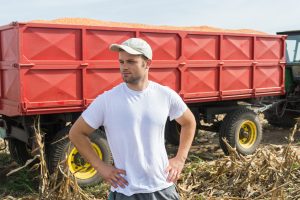Can your community organization use up to $30,000 to prevent injury and illness on the farm? Apply for a Great Plains Center for Agricultural Health (GPCAH) pilot grant.
Press Release FOR IMMEDIATE RELEASE April 26, 2022 CONTACT: Jenn Patterson, GPCAH Center Coordinator Jennifer-j-patterson@uiowa.edu GPCAH funds multiple pilot projects (up to $30,000 each) per year intended to promote innovative outreach and research efforts targeting...Drought can lead to more than the summertime blues in farmers
Press Release
For Immediate Release: September 17, 2021
Contact: Jenn Patterson, MLitt, GPCAH Center Coordinator Jennifer-j-patterson@uiowa.edu, 319-335-4207
It comes as no surprise to Midwesterners that farmers are vulnerable to extreme weather events, but have you considered additional ways to combat occupational stress when it comes to drought planning for yourself and your ag community?
Jesse Berman, Assistant Professor at the University of Minnesota, and his team published a peer-reviewed paper in Science of The Total Environment looking at the association between drought conditions and increasing occupational stress among nearly 500 Midwest farmers over 2012-2015. Read the full paper at https://doi.org/10.1016/j.scitotenv.2021.149245.
Researchers examined the relationship between drought conditions and measures of job-related stress (job strain ratio). The study identified that the job strain ratio increased during drought conditions that occurred during the growing season. Increased stress related to drought was nearly four-fold greater than stress associated with other factors, such as reporting pain in multiple body parts.
While we know that lack of rain causes stress, this study quantifies the trend and lends evidence to the need for mental health interventions. The authors suggest including information on health risks and mitigation strategies during early phases of drought conditions, with increased mental health resources for vulnerable populations.
This understudied threat to public health is particularly important due to increasingly hotter and drier growing seasons in North America and could provide important data for federal early warning systems and preparedness policy.
“Incorporating health into drought early warning plans is a growing priority of the National Integrated Drought Information System,” Berman said. “Studies that evaluate health risks from extreme weather are incredibly important for protecting both current and future farming populations that suffer disproportionately from natural disaster events.”
Berman received a pilot grant from the Great Plains Center for Agricultural Health at the University of Iowa in 2019 to fund this study. GPCAH is funded by the Centers for Disease Control and Prevention (CDC, U54 OH 007548).
For more information about how farmers get hurt and how to prevent these injuries, visit gpcah.org and select “resources” from the menu options.
Contact information: Jesse Berman, PhD, Environmental Health Sciences, School of Public Health, University of Minnesota berma186@umn.edu.
CDC COVID-19 Guidance for the Agricultural Industry
The CDC has developed a new COVID-19 guidance document specifically for the agricultural industry. THE GPCAH and other NIOSH Ag Centers were involved in the development of the technical guidance and are working together to develop user-friendly, practical resources...Studies may be underreporting farm injuries
Press Release 
University of Iowa College of Public Health
FOR IMMEDIATE RELEASE: September 12, 2019
CONTACT: Jenn Patterson, MLitt, GPCAH Communications Coordinator, Jennifer-j-patterson@uiowa.edu, 319-335-4026
Studies may be underreporting farm injuries
This first-of-its-kind study states that relying on workers’ compensation data alone might lead to inaccurate results such as incorrect injury counts and unreported farmer injuries.
University of Iowa College of Public Health researchers have determined workers’ compensation records alone are not enough when it comes to identifying work-related farm injuries. The article, published online in the American Journal of Industrial Medicine in June 2019, is unexpected because researchers commonly use workers’ compensation information to determine the number and type of incidents occurring within a certain occupation. However, researchers have found that this resource does not include the majority of farming-related injuries in Iowa.
Principal Investigator Corinne Peek-Asa, PhD, says this is important for advancing scientific knowledge because it contradicts the sole use of this commonly mined resource. If investigators are collecting and analyzing insufficient data, then their results could be biased and inaccurate. The study also justifies the need for researchers to use multiple sources for their work to glean a better picture of injuries occurring on the farm.
“These findings are important for researchers, but they are also important for insurance providers who might also underestimate workplace injury risk among their agricultural clients,” said Peek-Asa. “Agricultural clients are using other products, such as property or home insurance, to cover these costs.”
The research focused on data from Iowa that allowed the researcher to identify both farm-related and occupationally-related injuries. Each state has its own regulations when it comes to reporting workers’ compensation data.
Read the paper published in the American Journal of Industrial Medicine at https://onlinelibrary.wiley.com/doi/pdf/10.1002/ajim.23040.
This study is supported by the University of Iowa Great Plains Center for Agricultural Health and the University of Iowa Injury Research Center.
Contact information: Corinne Peek-Asa, PhD, Associate Dean for Research, College of Public Health, Professor, Occupational and Environmental Health, Director, Injury Prevention Research Center, University of Iowa, Corinne-peek-asa@uiowa.edu.
